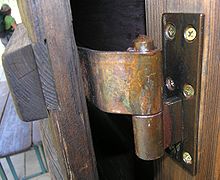Band (fitting)

A tape is a fitting for the movable attachment of doors , windows , shutters , flaps, lids and other components in the building industry.
The words band, hinge and hinge are often used synonymously. Depending on the context, hinge can be viewed as the generic term . Piano hinges are not related to door hinges and are more correctly called rod hinges.
A band in its original meaning is made from a steel strip or sheet metal strip . It is also called a long hinge because its length can roughly correspond to the width of the door or window sash that is to be suspended in a movable manner. This elongated, mostly horizontal part of the tape is called the tape tab . In particular, tape tabs that are square or upright are also called tape tabs . The other end of the steel strip is bent into a cylindrical roller, which is pushed over the axis of rotation when the wing is installed. The axis of rotation is also known as pins , pin or pintle referred to and is usually part of a Angel , a frame hinges or a second tape tab.
The hinge straps are usually connected to the ground with screws, rivets or nails or, in the case of the Fitschenband, inserted into the door leaf and frame. In metal construction, on the other hand, the rotating rollers are also welded directly to the steel structure. In the past, hinges or clamps were either screwed to the frame , hammered into a solid wooden dummy block or mortared into the masonry .
The turning role on belts is usually more massive and voluminous than on hinges . In the case of bands, the upper part of the band can usually be lifted upwards from the lower part or from the tang or clamp, while a hinge often cannot be divided without tools, since its axis of rotation is positively connected to the flap of the hinge. Even the two parts of modern belts often cannot be detached from one another without tools. Concealed door hinges as well as furniture hinges ( furniture hinges ) are often complicated constructions with various movable tabs that are riveted to one another.
history
In many residential buildings of the early days, the door was open during the day and was only closed at night - to protect against domestic animals roaming free or from predators - with an often only half-height adjustable wickerwork grid made of branches; Windows were unknown anyway. In a later development phase, the doors or gates were provided with tenons made of wood or stone, which were embedded in the threshold and in the lintel . Such mortises can still be seen from time to time in ancient and medieval gate and house ruins. Depending on their size or weight, such doors or gates could only be opened or closed by several men (e.g. in castles , mosques or palaces ).
Door hinges
- Long ligament, angular ligament, cruciate ligament
- The long hinge strap attached to the door leaf is made from a single elongated piece of steel strip. The lower counterpart is attached to the frame or frame and is referred to as a door hinge , clamp or, outdated, hasp or reel (= hook-shaped ). The door hinges attached to the door leaf with screws or compressed bolts ( rivets ) were often designed ornamentally by the blacksmith. If the door leaves gave way and sagged over time, the roll of the strap or the door hinge was bent accordingly.
- Fitschenband, screw-on band, roller band
- When finely profiled panel doors became widespread, Fitschen bands were developed that were embedded ( mortised ) into the door leaf and were therefore hardly visible any more. The hinge flap is pushed into a slot in the door frame from the side and fastened with pins . Externally, the Fitschenband similar to the Screw- in which the hinge strap are screwed in the fold of wings and frame. Both variants are also called roller hinge , because when the sash is closed, only the rotating roller ( axis of rotation ) is visible.
Modern, so-called 3D straps are pushed into (double) pockets and clamped there, which are mounted in recesses in the frame. This enables the door leaf to be adjusted in all three levels. - Clamp strap
- is screwed onto the door or shutter, visible from the outside. The clamp (the tang ) as an L-shaped counterpart was usually hammered into the frame or the frame or, more rarely, screwed. Today, cloak hinges are almost only used on simple board or lath doors, on window shutters or in rustic furniture construction. Decorative latch hinges on doors in historical buildings or as richly decorated wrought iron or pewter fittings on antiques are known .
- Pan band
- can be processed and adjusted in an excellent industrial way and is a special form of the clamp hinge, which differs from the clamp hinge in that it is stored in a "rotating pan" and is particularly suitable for heavy goals. Like the tapes mentioned above, this is rarely used today.
- Drilling tape
- The drill-in hinge is most commonly used today. The bolts of these hinges are provided with a thread so that they can easily be screwed into the drilled holes in the door leaf and frame and adjusted. More elaborate hinges contain an internal mechanism that allows the position of the door hinge to be adjusted.
- Paumelle
- is a hinge that can be found on butt-closing doors (= flush with the door frame). Paumellen is also available with ball bearings, especially for buildings with high loads.
- Swing door hinge
- is provided with two spring-loaded hinges and enables swing doors to swing through in both directions. Such doors are known as saloon doors in westerns .
- Pivot hinge
- is mainly used for metal doors. For wooden doors, most likely to be used with a floor spring.
- Vault tape
- is a special swivel joint, completely concealed in the frame and door leaf, which guarantees the opening of a door, whereby no links or hinge parts between the leaf and the frame can be seen or seen when the leaf is closed.
Ribbon windows
- Fitschenband
- is pushed into a slot in the window sash from the side (wedged)
- Clamp strap
- is screwed onto the window sash from the outside; was also used in a combined design with corner angle (angle tape); today only used for very simple or historical window constructions
- Drilling tape
- is mainly used on windows that only have a rotating function
- Tilt & Turn fittings
- are characterized by the fact that windows can either be opened completely or tilted for ventilation; Today they are mainly used as complex locking systems with single lever operation in combination with Fitschenbänder; earlier, the function was also simple sliding bolt made
Furniture door hinges
- Fitschenband
- is pushed (wedged) into a slot in the furniture door from the side so that only the rotating roller (axis of rotation) protrudes.
- Clamp strap
- Today it is mainly used for furniture where you want to follow certain styles (antique furniture).
- Cylinder belt
- is a hinge that can be used for different types of furniture constructions, as it is available in different crankings, for rebated and flush furniture doors.
- Pivot hinge
- is let into the door from above and below. This means that the fitting can not be seen from the outside or the inside. Pivot hinges are extremely robust and hardly wear out because their construction is very simple. Since the pivot hinge, which requires an internal door construction, can only be assembled by hand, it is hardly used today.
- Drilling tape
- is rarely found in the furniture sector today.
- Pot hinge
- is probably the most common type in the furniture sector today. The eponymous pot is screwed or clamped into a hole in the furniture door. It is connected to the base plate on the body wall via the articulated arm (screwed or mostly clicked into place today). These pot hinges can usually also be adjusted three-dimensionally. There are cup hinges with different opening angles (normally 90 degrees, maximum 180 degrees) and from individual manufacturers for special purposes (e.g. for corner cabinets). Often these hinges are also used with a snap mechanism (spring), which saves the need to attach a locking magnet or a snap lock.
Web links
- Tapes . In: Lueger: Lexicon of the entire technology .
Individual evidence
- ↑ a b R. Schmiedel, H. Raddatz: Building studies for laypeople . Reinhard Welz Vermittler Verlag, Mannheim 2005, ISBN 3-938622-66-0 , p. 151 ( limited preview in Google Book search).
- ↑ Angel . Duden.de, spelling
- ↑ hasp. In: Jacob Grimm , Wilhelm Grimm (Hrsg.): German dictionary . tape 10 : H, I, J - (IV, 2nd division). S. Hirzel, Leipzig 1877 ( woerterbuchnetz.de ). reel . In: Jacob Grimm , Wilhelm Grimm (Hrsg.): German dictionary . tape 10 : H, I, J - (IV, 2nd division). S. Hirzel, Leipzig 1877 ( woerterbuchnetz.de ).
- ↑ Safe tape. Register information from the DPMA



